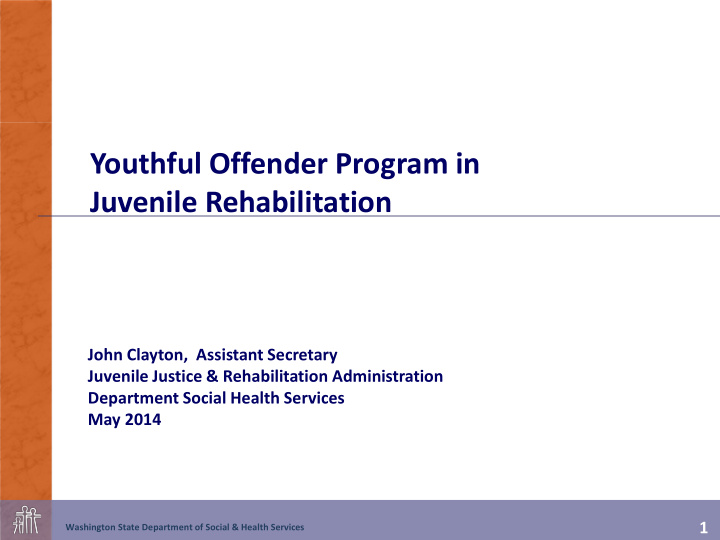



Youthful Offender Program in Juvenile Rehabilitation John Clayton, Assistant Secretary Juvenile Justice & Rehabilitation Administration Department Social Health Services May 2014 1 Washington State Department of Social & Health Services
Juvenile Rehabilitation serves youth who are sentenced as adults when under the age of 18 RCW 72.01.410 provides DOC the ability to transfer a child to Juvenile Rehabilitation to: - Address the child’s needs and correctional goals - Provide age-appropriate programs and housing environment - Offer access until youth turns 21 2 Washington State Department of Social & Health Services
Youthful Offenders in Juvenile Rehabilitation Population • 520 youth total in JR residential programs • Of these, 54 (10%) are youth serving adult sentences Live at: • Green Hill School, Chehalis (52) • Echo Glen Children’s Center, Snoqualmie (2) 3 Washington State Department of Social & Health Services
Age of Youthful Offenders in Juvenile Rehabilitation 25 20 15 10 5 0 age 16 age 17 age 18 age 19 age 20 4 Washington State Department of Social & Health Services
YOP youth complete sentences in JR and DOC Of the 54 YOP youth in JR: - 28 will eventually transfer to DOC to complete sentence - 26 will likely release from a JR facility 5 Washington State Department of Social & Health Services
What works with high-risk youth offenders? • Incorporating youth needs, cultures and ways of learning into treatment • Targeting dynamic risk factors in treatment • Using cognitive-behavioral principles and practices • Incorporating educational strategies in treatment • Implementing programs incorporating life skills. • Utilizing family-based interventions in programming 6 Washington State Department of Social & Health Services
Preparing Youth for the Future - Job preparation and skill development - Career path assessments - On-the-job training - Certification programs - Vocational rehabilitation services for eligible youth with disabilities - Educational preparation - Focus on linkages back to community schools - Improving in math and reading while in JR - Attaining diplomas, GEDs - Family connection - Increasing involvement in planning for future while in care - Community engagement - Mentors - Positive community role models willing to give a second chance - Cultural activities sponsored by community members 7 Washington State Department of Social & Health Services
Recommend
More recommend